|
|
|
Autoroutes (expressways, motorways) connect the major cities and regions in France, making it easy to zoom from one to another. Many autoroutes are operated by commercial companies, prominent among them Vinci Autoroutes. Types of PaymentRules for tolls, and paying them, are set by the operating companies according to government regulations. Here are examples for Vinci-operated autoroutes. Other companies' rules are similar.
Phasing Out the TollboothIn 2024, France began introducing flux-libre ("free-flow") lanes at tollbooths on some autoroutes. In these lanes, tolls are collected automatically by sensors and cameras: you drive through the lane at speed and these devices record the passage of your vehicle and the toll ypu owe. You pay by card on the company's website, or by card or cash at a tabac (the ubiquitous little corner shops in France), or via an account with the autoroute company. You have at least 72 hours to pay the toll before you're subject to a fine for non-payment: 10€ at first, 90€ later. If you live outside of Europe and don't pay the toll, you'll hear from a collection agency in your own country—not fun. Tolls apply to all vehicles: cars registered in Europe, or in other countries, or rental/hire cars. The program was initiated on the A4 east of Metz, and on the A13/ A14 toll highways between Paris and Normandy, both operated by Sanef (website in English). Here's how to pay your non-EU or rental/hire car tolls from flux-libre: 1. With your smartphone, take a photo of your vehicle's license plate, or note it on paper, so you have it with you when you pay. 2. When you drive on a toll highway, note which company operates the tolls! There's a list on the ASFA website (in English). 3. Within 72 hours of incurring the toll, pay on the company's website, or go to a tabac participating in the flux-libre program and pay. Tollbooths are Still ThereOn some autoroutes, you take a ticket when you enter the highway, and pay the toll when you exit. On others, you may encounter a single tool booth during your drive, and pay a set price for the toll. Highway tolls may be paid with euro coins and notes/bills, or certain credit or debit cards. Some toll booths also now offer péage sans contact. Péage sans ContactIf your credit/debit card is RFID/NFC-enabled, you need only touch your card to the contactless-payment symbol on the toll machine to pay the toll. This is the easiest and safest way to pay, but not all toll booths yet have this feature. You may have to insert your card instead. Look for this symbol:
Note: contactless smartphone payment is illegal!In January 2025, a French motorist was fined 135€ for using Apple Pay on his smartphone to pay motorway a toll. Vinci, the operator of the motorway, had encouraged smartphone payment, but technically, it's illegal: drivers can't use their phones for any purpose while on a highway! President Macron has called for a change in the law to allow contactless smartphone payment, but until this makes its way through French bureaucracy, it's best to pay by contactless credit or debit card. Credit/Debit Card or Euro CashTo pay with euro cash. look for a toll gate marked by a green downward-pointing arrow:
You should be able to pay the toll with an acceptable credit/debit card, euro coins and/or notes/bills at any such gate. If you see only a 't' symbol, or a stylized logo of credit cards, and no green downward arrow, you may not be able to pay with euro cash at that toll gate. Don't go there! Drive into the gate with the green downward-pointing arrow to the toll machine:
1. Insert your toll ticket in Slot 1 (Ticket). The toll amount will appear in the Prix digital display above (for example, 2 euros 30 centimes, as seen above). 2. Insert your French credit card (see below) in Slot 2 (Carte), or touch your RFID/NFC-enabled card or smartphone to the RFID symbol (if there is one); or insert euro coins (10-, 20- and 50-cent, 1- and 2-euro coins) in the slot marked Pièces and/or euro notes/bills (5, 10, 20 and 50 euros) in the slot marked Billets. In case of overpayment, change may be returned in the Monnaie (excess payment) hole. When the full amount of the toll has been registered, the gate barrier will rise. 3. Push the Récu button to obtain a receipt (if desired). Proceed through the toll gate. 4. In case of a problem, press the Assistance intercom button (upper right-hand corner) and wait for assistance. Don't back up! Toll AmountsTolls are charged by distance, so a longer drive will require more and larger coins and notes/bills. You can calculate the anticipated toll amount for any autoroute trip on the ASFA website (see below). Be sure to have a sufficient and varied supply of notes and coins before entering a toll highway! Don't depend on chance—the euro cash you may have in your pocket at the time—to get you through. Prepare a special reserve of coins and notes/bills for highway tolls as the tolls can be high. The 8-hour, 775-km (482-mile) drive by Autoroute from Paris to Marseille in a Classe 1 vehicle (passenger car) incurs tolls of 66.10€. Credit & Debit Cards
Some toll gates are marked by stylized credit card logos meaning you may pay only by credit card at that gate. Cash is not accepted at toll gates marked by the credit card symbol. Only certain credit and debit cards are accepted for payment of tolls. Cards must contain a computer chip (puce), but not all chip cards are accepted! More... Highway operator Vinci notes that the following types of cards are accepted: CB (Carte Bleu), Visa, Visa Electron, Mastercard, Maestro, Total GR, DKV, Eurotrafic, Esso Card, euroShell. It also advises, cryptically, that "cards issued in some non-European countries are not accepted," but does not list which countries. Helpful!
Some toll machines are now equipped to interact with "touchless" RFID/NFC credit/debit cards (with the little 4-waves symbol). If your card bears the RFID/NFC symbol, you can try using it. You might not want to insert your only credit or debit card into a highway toll machine as there's a chance the machine may not return it. If you are carrying other cards with which you can continue to pay your travel expenses, you may decide to try it.
Estimating Your TollsASFA (Autoroutes & ouvrages concédés), the association of companies operating autoroutes in France, has a useful website, autoroutes.fr, that provides information in French and English on expressways/ motorways in France, including a distance, time & toll calculator, estimated motor fuel usage and cost, and other information. More... Big French Traffic JamsSeveral times each year, French highways are jammed with traffic. These times can often be predicted. Real-time traffic reports are available for all of France on Bison-Futé, a French government website for...predicting traffic jams. More... Parking in FranceParking can be as complicated as paying highway tolls. There are easy ways and complicated ways. Here's everything you need to know. More... Priorité à DroiteIf you don't know what that phrase means—priorité à droite—you must learn, and quickly, before there's an accident. When two cars meet on the road, which one goes first? That's priority, France has rules for it, and you must learn and follow them. More...
|
|
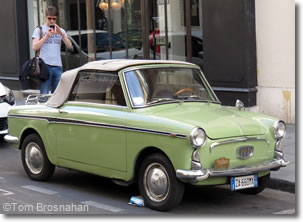
Cute little car on a Paris street...
Tolls from Paris to:
Hotel & Apartment Search Map:
|




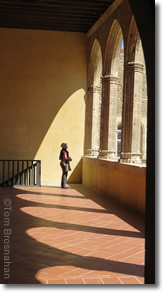

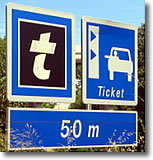

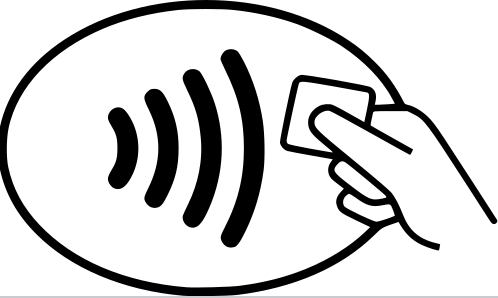
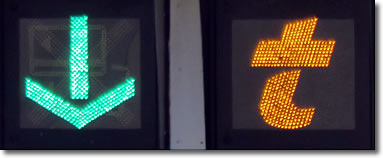
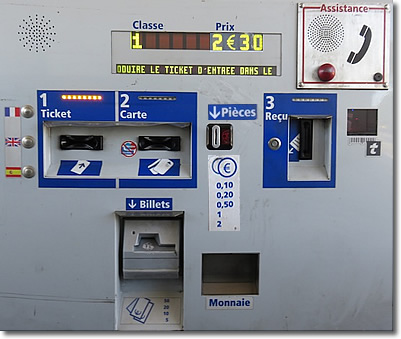

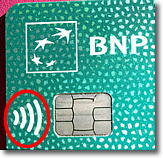
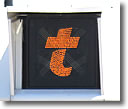 Télépéage symbol
Télépéage symbol

